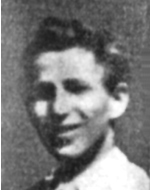Rubinstein, Moshe (Aussie)
Moshe was born in 1929 in the town of Mohac in southern Hungary, in the province of Bernia, grew up in a community of assimilated Jews and attended a public school in his hometown, but after completing six classes when the decrees became more severe, On the eve of World War II, several hundred Jews lived on the eve of World War II, when the war broke out in September 1939. After the war between Hungary and Germany, the Germans did not reach the country, but the Jews suffered greatly from the increasing anti-Semitism of the Hungarian population. Many young Jews were sent to labor camps of the Hungarian army In May 1944, a ghetto was set up near the ghetto, where about 5,000 people were imprisoned, most of whom were deported a few months later to Auschwitz, where they were murdered. After the liberation of Hungary from the Nazi occupation, Moshe moved to Budapest, began working and joined a Zionist youth organization, and with his friends emigrated to Germany, and from there they tried to immigrate to Israel. The illegal immigrants to Mandatory Palestine, “Knesset Yisrael.” The ship was caught by the British and its immigrants were deported to a detention camp in Cyprus. Moshe waited in Cyprus until receiving a permit to immigrate to Israel as part of the Youth Aliya, and arrived in Israel on August 27, 1947. Upon his arrival, he was sent to an immigrant youth group in the Heftsiba farm at the foot of the Gilboa. He absorbed himself in the kibbutz, worked diligently in the marble quarry and tried to learn Hebrew. The studies were hard on him, but his behavior and effort made him fond of the members. When the War of Independence broke out, Moshe demanded that they enlist him. The society and the counselors objected to this, because in their opinion they had not yet taken root in the life of the country, but he insisted on his desire to enlist. In the end they agreed to his pleas and on April 1, 1948 he was drafted. For two weeks he was trained in a camp in Giv’at Zeid, then joined the “Haemek” battalion, the first battalion of the Palmach, and in late 1948 the battalion was transferred to the north, Against the Lebanese invasion army and the Arab “Rescue Army” under the command of Kaukji in mid-May 1948. In June 1948 the battalion was moved to the Latrun area to assist in the “Dani” operation to open the road to Jerusalem, ) Some members of the regiment, Moshe among them, were sent to assist in the defense of the Gezer group against the forces of the Arab Legion that were parked nearby. A few hours before the first truce broke out in the war, the Arab force, composed of a Legion Company, organized irregular and armored forces, attacked Kibbutz Gezer, the heavy fire that destroyed the defensive posts and paralyzed any possibility of organized resistance The Jordanians managed to break into the agriculture and conquer it.Though about thirty fighters and Moshe fell in. About thirty defenders were captured by the Jordanians and Kibbutz Gezer was liberated by the Yiftach fighters a few hours later. He was laid to rest at the Gezer cemetery. Moshe’s memory was placed in a booklet in memory of Hefziba’s fallen soldiers. This hero is a “last scion”. The survivors of the Holocaust are survivors of the Holocaust who survived the last remnant of their nuclear family (parents, brothers, sisters, sons and daughters) who experienced the Holocaust in the ghettos and / or concentration and extermination camps and / or in hiding and hiding in territories occupied by the Nazis and / Or fighting alongside members of the underground movements or partisans in the Nazi occupied territoriesDuring the years of World War II or after, he wore uniforms and fell in the ranks of Israel.
